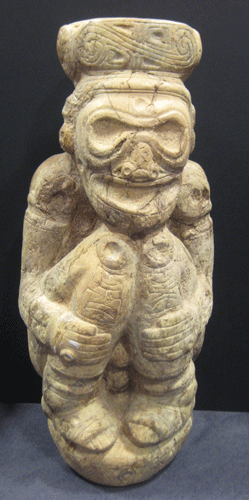Taino Stone Zemi Sculpture, 1100 CE - 1500 CE
Stone
11 x 23.5
FF.044
Further images
This is an extremely powerful and impressive example of Taino stone carving. It represents a zemi figure- the physical manifestation of a Taino god, spirit or ancestor. Flourishing in the...
This is an extremely powerful and impressive example of Taino stone carving. It represents a zemi figure- the physical manifestation of a Taino god, spirit or ancestor. Flourishing in the Caribbean c.1200-1500, the Taino developed a highly sophisticated religious system. At the apex of the Taino pantheon, were the gods who controlled the weather and encouraged fertility. Lesser deities included deceased Taino chieftains (caciques) and other ancestors. The Spanish colonists recorded that each chieftain had a temple-like structure in which he stored his zemi sculptures. Although many members of the community would have owned small zemi amulets, made of wood or shell, large-scale stone sculptures such as this one were the preserve of the Taino elite.
Seated in a ritual squatting position, the limbs of this figure are unusually naturalistic. In similar works the legs are often foreshortened, but here they are depicted full-length, clutched tightly against the chest. The feet are also carved in high-relief, and face inwards on the round pedestal. The shoulders are hunched and the arms grasp the chins, with each finger clearly delineated. Both the face and body are skeletal in appearance, with the joints indicated by deeply carved roundels. The detail on the reverse is astounding, with circular incisions to represent the spine and straight horizontal lines indicating the ribcage. Unusually two very deep roundels with notched lines around the perimeter, indicate the top of the legs/buttocks.
A flat surface is formed by the small platform above the head, the sides of which are lightly incised with ‘s’ shaped coils. When viewed in profile, it seems to represent some kind of basket supported by the figure’s head and shoulders. Many Taino stone sculptures had some association with the use of cohoba. This was a hallucinogenic powder ground from trees native to the region. It was used by shamans to induce to induce a trance-like state of mind in which they would be able to communicate with the souls of the dead. The small circular platform on this piece may have been used as a grinding surface or to support other implements associated with this ritual. The quality of the carving and the boldness of the design mark this work out as a true masterpiece. (AM)
Seated in a ritual squatting position, the limbs of this figure are unusually naturalistic. In similar works the legs are often foreshortened, but here they are depicted full-length, clutched tightly against the chest. The feet are also carved in high-relief, and face inwards on the round pedestal. The shoulders are hunched and the arms grasp the chins, with each finger clearly delineated. Both the face and body are skeletal in appearance, with the joints indicated by deeply carved roundels. The detail on the reverse is astounding, with circular incisions to represent the spine and straight horizontal lines indicating the ribcage. Unusually two very deep roundels with notched lines around the perimeter, indicate the top of the legs/buttocks.
A flat surface is formed by the small platform above the head, the sides of which are lightly incised with ‘s’ shaped coils. When viewed in profile, it seems to represent some kind of basket supported by the figure’s head and shoulders. Many Taino stone sculptures had some association with the use of cohoba. This was a hallucinogenic powder ground from trees native to the region. It was used by shamans to induce to induce a trance-like state of mind in which they would be able to communicate with the souls of the dead. The small circular platform on this piece may have been used as a grinding surface or to support other implements associated with this ritual. The quality of the carving and the boldness of the design mark this work out as a true masterpiece. (AM)







